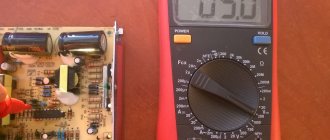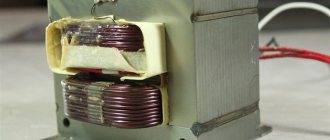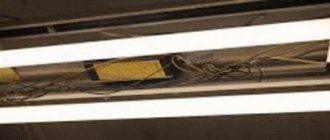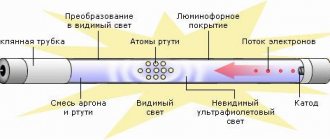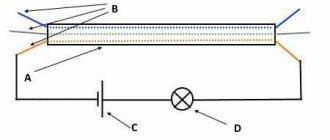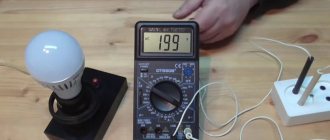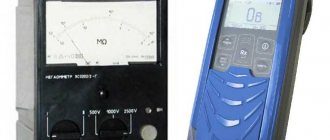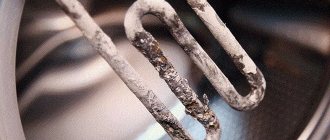In the context of rising energy prices and increasing electricity tariffs, the issue of saving electricity in houses and apartments has become urgent for the population. Various technologies have been developed to make it possible to use electrical appliances that are more economical than those produced just a few decades ago. When organizing indoor lighting, fluorescent light sources, or fluorescent lamps (FLLs), have been used for quite some time.
They, providing the same illumination as conventional incandescent light bulbs, consume 5-7 times less electricity than their predecessors. Despite the fact that even more economical LED sources have appeared, their price is so high that currently the use of lamps with LDS remains the most rational solution.
During the operation of lamps, breakdowns and failures in the operation of some elements are always possible. For repairs, you need to know how to check fluorescent lamps with a tester. To do this, you need to understand how such light sources are structured and how they work.
Starter device for fluorescent lamps
The design of this element is quite simple. Each model produced by a specific manufacturer has its own technical characteristics. This should be taken into account when choosing lamps. The starter is a glass cylinder containing an inert gas. It can be a mixture of helium and hydrogen or neon. Fixed metal electrodes are soldered into the cylinder. Their conclusions pass through the sockets.
The cylinder is located inside a plastic or metal case with a hole on top. The most popular material for making the case is plastic. A special impregnation allows such a housing to cope with high temperatures. Any starter for fluorescent lamps has only two legs (contacts).
If you remove the structure from the body, you can see the flask itself. You can also see that some element is connected parallel to the electrodes of the flask - this is a capacitor. Its capacity is about 0.003-0.1 microfarads. The capacitor is designed to perform two functions at once:
The capacitor reduces the voltage pulse that is formed when the electrodes open and increases its duration.
Due to parallel connection with the electrodes, the capacitor reduces the likelihood of their welding (sticking). A similar phenomenon can occur during the process of opening the electrodes due to the formation of an electric arc. The capacitor extinguishes the arc in the shortest possible time.
Expert opinion
Viktor Pavlovich Strebizh, lighting and electrical expert
Any questions ask me, I will help!
As a stand, you can take a ready-made lamp and replace its standard parts with tested parts, or you can assemble a simple circuit. If there is something you don’t understand, write to me!
General provisions
Starters of different modifications and types are structurally very similar to each other. The components of the starter are a small-sized gas-discharge lamp, a bulb, which is made of glass, and an inert gas is placed inside it.
The lamp is located inside a housing, which is made of metal or a variety of plastic, and may have a hole in the top of the device. Starters, thermal and operating on the glow discharge principle, are equipped with a capacitor, which is designed to smooth out voltage surges and extinguish the arc.
The capacitor also serves to reduce radio interference; it is connected in parallel to the starter contacts.
Why is a starter needed in fluorescent lamps?
This element is the main one in the design of fluorescent lamps. Without it, electromagnetic ballasts will not be able to function. The main purpose of the starter is to start the mechanism and ignite the inert gas located in the gas-discharge flask. The starter works like a switch - it opens and closes an electrical circuit.
The installation of a starter is dictated by the need to perform two important functions:
- - circuit closure. Allows you to heat the lamp electrodes, thereby facilitating the ignition process;
- - chain break. Occurs immediately after heating the electrodes. As a result of the opening, an increased voltage pulse is formed, which causes breakdown of the gas gap of the flask.
The choke plays the role of a stabilizer and transformer. It maintains the required current of the lamp filaments, creates a voltage pulse necessary for breakdown of the lamp and stabilizes the arc burning process.
Verification methods
It is advisable to use instruments to diagnose the condition, but if they are not available, the assessment of the condition can be done without them.
Without tester
You can check the choke of a fluorescent lamp without a tester and other devices (at least an indicator screwdriver). But the reliability of these methods is limited.
- First of all, this is the behavior of the lamp . If, when voltage is applied, it flashes, but does not reach a steady glow, then there is a reason to check the inductor (although there may be other reasons, including a malfunction of the lamp itself). If there is a break in the coil, there will be no blinking - the circuit will not show any signs of life at all.
- Visual inspection . If there is blackening, swelling, or traces of local overheating on the throttle body - all this is a reason to doubt the serviceability of the device. It must be replaced or diagnosed using instruments.
- Installation in a known-good lamp instead of a standard one . If after replacement the lighting fixture stops working, then the problem is in the throttle. Or, conversely, install a known-good choke into a non-working lamp. If the problem is resolved, then the problem has been found.
You can assemble a stand for testing ballast elements. This makes sense if you have to maintain the lighting system of a building, office, workshop, etc., built using fluorescent lamps. As a stand, you can take a ready-made lamp and replace its standard parts with tested ones, or you can assemble a simple circuit. It uses a regular 220 volt incandescent lamp.
To check the choke of a fluorescent lamp, the properties of the inductive reactance of the choke coil are used. Various situations are possible:
- the lamp is lit at full intensity - the inductor is working, its reactance limits the current in the series circuit;
- the lamp burns at full brightness - there is an interturn short circuit, the inductance of the coil is small, the reactive component of the resistance is close to zero;
- The lamp does not light - there is a break inside the throttle.
It will not be possible to check elements of electronic ballasts (EPG) on such a stand. It works on a different principle.
If a choke with a breakdown on the body is tested, then when power is applied, mains voltage will be present on its body. The ballast elements must be connected when the voltage is off. Take precautions when serving food.
Using a multimeter
The multimeter provides greater opportunities for checking ballast elements and the reliability of such testing is higher.
On a cliff
To check for an open circuit, a multimeter in resistance measurement mode (or audio testing) must be connected to the ballast terminals. If the device is working properly, the tester will show a resistance of several tens of ohms (depending on the type of inductor, for most common models it is about 55..60 ohms).
Expert opinion
Viktor Pavlovich Strebizh, lighting and electrical expert
Any questions ask me, I will help!
If you check the choke of a fluorescent lamp with a multimeter, you can find either its working condition, in which the measured active resistance corresponds to its passport data, or you can encounter inconsistencies. If there is something you don’t understand, write to me!
What is a starter
Gas-discharge light sources have long been part of everyday life. They are used for lighting residential and industrial premises and provide stable lighting. It is quite stable when there is no degradation of elements in the circuit.
A typical circuit includes a lighting fixture, an inductor, and a trigger device. The choke is a regular inductor and is also involved in starting. But the main function is protection. The coil limits the voltage during a surge. It is the most durable element of the circuit.
The starter is needed only to start the circuit using gas-discharge lamps. Further, he does not take part in the operation of the lamp.
A fluorescent lamp (aka gas discharge or daylight) is a sealed bulb. It contains electrodes located on different sides. Its inner part is coated with phosphor - a substance that glows when electrons are emitted. The tube contains mercury vapor.
The standard gives the lamp 10 seconds to turn on from the moment voltage is applied.
Why do fluorescent lamps burn out?
Considering gas-discharge lamps, one cannot help but mention their similarity with traditional incandescent lamps (IFL). As in LN, the glow is created by heating spiral tungsten electrodes. Long and intensive use leads to overheating, contact wear and failure.
In LDS, the elements are coated with a layer of active alkali metal. This solution allows you to extend the life of the lamp and reduce the negative impact of high temperatures. This stabilizes the discharge between the electrodes, which helps maintain integrity.
However, the coating does not last forever and is sensitive to frequent switching on and off. Gradually, the metal crumbles, and the tungsten electrodes begin to contact each other. The discharge passing through them heats the material and leads to final burnout. This can be seen on old bulbs: small darkened areas of phosphor near the contacts.
What kind of lighting do you prefer?
Built-in Chandelier
During operation, it is important to monitor the integrity of the flask. If there is damage, burnout will not take long to occur
If an orange glow is observed at the edges of the flask, it means air is getting inside through the hole. It is impossible to repair the element, only replace it.
Expert opinion
Viktor Pavlovich Strebizh, lighting and electrical expert
Any questions ask me, I will help!
Depending on the size of the device, a daytime fluorescent lamp costs from 40 rubles to 1 thousand or more for industrial models. If there is something you don’t understand, write to me!
Features of choice
Advantages and disadvantages
Advantages of using modern starters:
- Environmental Safety;
- Extending the service life of lamps;
- Durability;
- Simplicity and ease of installation.
It is important to remember the disadvantages, and these are:
- Low reliability;
- Voltage dependent;
- Variation in the response time of electrode contacts.
Technical requirements
All technical means, equipment and components must comply with technical conditions and rules. Thus, the following regulatory documents apply to starters:
- GOST 8799-90 “Starters for tubular fluorescent lamps. Technical conditions";
- GOST R IEC 60155-99 “Glow discharge starters for fluorescent lamps.”
How to check a fluorescent lamp with a multimeter if it does not work
- The device does not turn on - the cause of such a malfunction may be the loss of functionality of the lamp or breakage of wires, circuits and contacts. It is necessary to replace the lamp; if this does not help, you should look for the cause in the connections and wires; perhaps there is a circuit break somewhere.
- The lamp begins to blink, but does not light up until it glows steadily - This is due to a short circuit in the wires or between the contacts. It is necessary to check the insulation and replace the wires if necessary. If this does not help, the lamp itself may need to be replaced.
- A dim glow on both or one end of the device - this happens due to a violation of the seal of the flask. Such a device must be replaced; it cannot be repaired.
- Darkening of the ends and complete shutdown during operation - the cause of this phenomenon may be a faulty ballast. You should completely replace it and test the device again.
- Cyclic dimming and ignition of the lamp - most often the cause of this malfunction is the starter. It should be replaced, as in the case of a broken ballast.
- Burnout and blackening of the ends during switching on - this happens when the incoming voltage does not correspond to the rated voltage. The ballast resistance cannot withstand the increased load, and the lamp immediately burns out. It could also be due to a faulty ballast. In this case, the ballast is also replaced with a new one.
Luminescents: how the device works
All daytime luminescent products are divided according to shades and brightness levels into:
Yellowish ones are suitable for home use. They soothe and do not cause irritation. For the office they choose warm ones - they are suitable for painstaking work. For industrial and public institutions - cold, stimulating the organs of vision, stimulating the nerve endings.
The “cold” lamp stimulates and irritates, installed, for example, in hospitals
Structurally, the product consists of a glass bulb of different shapes (round, oval, shaped).
The flask is coated with phosphor - this is a chemical solution that increases light output.
During installation, you may need a hidden wiring detector.
- electric current, using a choke, acts on the spiral electrodes;
- the electrodes heat up quickly (in 2-3 seconds);
- the electrodes heat the mercury, which begins to evaporate;
- mercury gas (vapor) is formed inside the flask;
- the gas stimulates the phosphor;
- the fluorescent light bulb “lights up”.
In order for the current to act on the electrodes with the required force, a choke element is required. It promotes the “ignition” of the spiral electrodes. Looks like an induction coil with a core.
Current affects the part. Voltage accumulates there and is transmitted to the spiral electrodes.
To prevent the fluorescent lamp from overheating, there is a starter inside. It is a neon light bulb. It is necessary to open the circuit and turn off the flow of current when the spiral-electrodes have become sufficiently hot. The process happens automatically.
The fluorescent lamp starter ensures timely opening of the electrical circuit
Any daytime fluorescent structure must be certified and licensed. This is indicated on the packaging. Before purchasing, it is advisable to ask the seller about the availability of documentation for the device. They indicate the type, expiration date, information about the permission to use the product.
Faults in the electronic ballast
In modern LLs, electronic ballasts (EPG) are used more. To check it, take the same known-good device with similar parameters and connect it in accordance with the diagram to the lamp being tested. If the lamp works normally, then the cause of the malfunction is in the unit.
Don't rush to throw away the old unit. It is quite possible that the fuse has just blown (figure below - number 1). It is replaced with a similar one, with the same diameter, fusible wire or insert.
If the fuse is working, use a multimeter to check all resistors, capacitors and other parts in the circuit.
When the filaments barely glow, this is most often due to a breakdown of the capacitor between them (number 2 in the figure). It is replaced with a similar one, but with an operating voltage of about 2 kV. On cheap ballasts, capacitors of only 250-400 V often fail.
Transistors (number 3 in the figure) may fail due to voltage surges. When operating a welding machine or other powerful load, it is better to turn off the LL. It is easy to find a replacement using an analogue, the designation of which is found in the tables, or take a used ballast.
The decoding of the first letters of foreign manufacturers is of an advertising nature, which creates difficulties in determining the interchangeability of lamps.
After replacing each radio component, the functionality of the electronic ballast is checked by connecting it in series with a 40 W incandescent lamp.
Without a load, the pulsed electronic ballast device quickly fails. Therefore, in circuits with electronic ballast, special attention should be paid to the absence of contact faults.
Therefore, before turning on the LL, it is necessary to ensure the reliability of the electrical circuit contacts.
A switching power supply for a used energy-saving lamp may well be suitable even for a large LL. You need to remove the plastic base and correctly connect the contacts of the bulb to the filaments of the tube.
When installing electronic ballasts from another lamp, the power of the power supplies should be close in value.
It is not always possible to find the same device for the built-in ceiling lights with 4 lamps to replace the power supply.
Electronic ballast is especially afraid when phase and zero are confused.
Checking the fluorescent lamp choke (with and without a multimeter)
Fluorescent lamps often become unusable due to filament burnout. You can restore a second life to such a lamp using an unconventional starting scheme, repeatedly tested by folk craftsmen.
Expert opinion
Viktor Pavlovich Strebizh, lighting and electrical expert
Any questions ask me, I will help!
A more detailed check will consist of testing each element separately, but this one will take much more effort and will require you to have certain knowledge in this area. If there is something you don’t understand, write to me!
Why does not it work?
Important: Dispose of fluorescent lamps correctly. Don't just throw them in the trash.
The luminescent structure may break, mercury will leak out, creating a threat to the health of households and neighbors. Disposal is carried out by special companies. If there is none in your locality, at least place the used product in several plastic bags and tie them tightly.
Most often (40 cases out of 100) starters break. This is a fragile part that can be replaced. Starters are sold in specialty stores or on online marketplaces.
The throttle “burns out” less often (in 10 cases out of 100). It also needs to be replaced in the same way as the starter. An unpleasant “burnt” smell will indicate such a breakdown. The element fails due to a winding break or excessive heating, which indicates a defective product.
Sometimes the cause of lamp inductor failure is a manufacturing defect.
The cost of a daytime fluorescent lamp (depending on the size of the device) is from 40 rubles to 1 thousand or more (industrial models).
How to check a fluorescent lamp with a tester
If an orange glow is observed at the edges of the flask, it means air is getting inside through the hole. It is impossible to repair the element, only replace it.
Expert opinion
Viktor Pavlovich Strebizh, lighting and electrical expert
Any questions ask me, I will help!
The lamp begins to blink, but does not light up until it glows stable. This is due to a short circuit in the wires or between the contacts. If there is something you don’t understand, write to me!
Measuring capacitance without a tester
If you don’t have a tester, you can check the capacitor by building a simple measuring device with your own hands. It consists of a light bulb and two wires. This device will need to touch the legs of the capacitor. If a spark passes between the legs, this means that the capacitor is working.
Despite all their shortcomings, today fluorescent lamps are the optimal type of lighting. Their advantages include both a long service life and minimal load on the electrical network of the illuminated room.
And in the event of breakdowns of fluorescent lamps, you can easily find their cause if you know how to use the simplest instruments - testers or multimeters. Using these devices, you can identify a specific faulty part of the lamp (starter, inductor or capacitor), after which it can be successfully replaced.
Fluorescent light bulbs are very often used today as light sources. They have many positive aspects that make them indispensable both in the lighting system of an industrial facility and in home lighting.
But due to the structural features, such light sources can fail. In such a situation, you do not need to immediately send the lamp for recycling, but you can try to fix it yourself. To do this, you need to check the starter of the lamp for functionality. After all, it is in this detail that the reasons for the malfunction of the fluorescent lamp often lie.
How to check a fluorescent lamp with a tester?
- electronic ballasts do not cause flickering of the LDS during its operation and do not create extraneous noise;
- a circuit based on electronic elements consumes less energy, weighs lighter and is more compact;
- the possibility of implementing a circuit that produces a “hot start”, in this case the cathodes of the LDS are preheated. Thanks to this switching mode, the service life of the source is significantly extended;
- The electronic ballast does not require a starter, since it is itself responsible for generating the voltage levels necessary for starting and operation.
Is it possible to check with a multimeter at home?
The easiest way to check is to use a similar lamp, install a fluorescent lamp in it and then connect it to the network. But there is not always a device with the same type of cartridge for replacement. In addition, the screw threads of the base and the socket may not match, and as a result, the electrical contacts simply will not close.
In this case, a very common measuring device, a multimeter, comes in handy at home. Among its modes you can find a “continuity test”, which easily determines the integrity of the electrical circuit.
- the appropriate mode is selected;
- the first probe is placed on the central contact, and the second on the side;
- readings are taken from the device.
The second mode often used for diagnostics is “resistance”. During the test, probes are also used and the initial values are compared with those detected by the multimeter. A small error in measurements may occur due to weak contact with the probes.
Electromagnetic ballasts
Electronic starting and control equipment is a board with various elements soldered onto it. The easiest way to check is to replace this element with a working one and connect the device to the network. If the lamp works, then the problem was in the ballast.
It will not be possible to ring the entire board with a multimeter from both ends. You will need to check each element separately. The work algorithm will be as follows:
Fuse. In order to ensure its functionality, you will need to check its integrity. Capacitors. Damage to these fluorescent lamp elements can be determined visually by swelling of the lower section of the “barrels”
You should also pay attention to the soldering points, which may be damaged and, as a result, contact will be lost. Transistor. This electronic ballast part most often burns out due to sudden power surges in the electrical network.
You can check the performance of the transistor using a multimeter. To replace it, just remove the same one from another board or purchase it in the radio parts department. Diodes. One of the simplest elements of the device, which can also be tested with any multimeter with the appropriate test mode.
You can compare the data obtained by the device with a resistance table taken from the Internet.
How to check a ballast choke without a multimeter
Without special measuring instruments, a faulty ballast may be indicated by the fire snake effect. You can visually observe it inside the lamp.
What does this mean? And this means, first of all, that there is an excess of the maximum permissible current. Because of this, the charge lost stability.
The lamp may also glow intermittently or flicker. If the ballast breaks down, the lamp will not light up the first time.
As a result, the starter will constantly start and stop, start and stop. From such frequent starts, blackening appears near the spirals at the ends of the lamp.
Another way to check without measuring instruments and a multimeter is with a test light. Its power should be approximately the same as the power of the throttle itself.
Connect it in series according to the following diagram with the ballast and watch how it lights up.
Expert opinion
Viktor Pavlovich Strebizh, lighting and electrical expert
Any questions ask me, I will help!
This device is part of the electromagnetic control equipment and, when working together with the choke, ensures the start of the process of forming a glow discharge in the LDS bulb when an alternating mains voltage is applied to the contacts of the lamp. If there is something you don’t understand, write to me!
Main characteristics
Thermal type starters have the following difference from analogues - this is a long time for starting a daylight source. Devices of this type consume a large amount of electricity during operation, which negatively affects their efficiency.
Another name for starters of this type is thermo-bimetallic; they are usually used when operating at low temperatures. The main difference from other types is that in the absence of voltage, the contacts are already closed, and when voltage is applied to the device, a higher impulse occurs.
Starters that use the glow discharge principle in their operation contain bimetallic electrodes made of alloys with different coefficients of thermal expansion. The operation of devices of this type is carried out as follows: when the lamp is turned on in the electrical network, voltage is supplied to the starter, the electrodes of which are open at that moment.
Under the influence of the applied voltage, a glow discharge occurs between the electrodes. A small electric current passes through the circuit and, under its action, the bimetallic electrodes of the starter heat up. They heat up and bend, which is caused by reactions taking place in bimetals under the influence of electric current, and this is what leads to the closure of the circuit.
After the circuit is closed, the glow discharge in the starter bulb stops. At the same time, the electric current heats the cathodes of the lamp, the starter electrodes are closed at this time and cool down, after cooling the starter contacts open.
Opening this circuit leads to the appearance of a special pulse with increased voltage, which is formed in the inductor and allows a breakdown of the gas in the lamp, and accordingly its ignition.
In starters that have a contact control system, switching processes turn out to be uncontrollable. In severe conditions, such as operation at low temperatures, the heating rate of the bimetallic contacts slows down, and accordingly the fluorescent lamp takes longer to light or even fails. However, the development of semiconductor electronics has made it possible to produce starters of a fundamentally new type.
Semiconductor starters are housed in a conventional standard housing containing semiconductor components. They meet all the requirements for starters in terms of power and supply voltage of the connected lamp. The operation of starters of this type, the formation of an impulse, occurs according to the principle of a key - heating and opening the circuit.
The most optimal parameters for this type of starter are devices with a standby ignition mode, in which the contacts open at the required voltage phase and at a sufficient heating temperature of the electrodes.
In starters that have a contact control system, switching processes are uncontrollable
Electronic ballasts for compact LDS
Relatively recently, fluorescent energy-saving lamps, adapted for standard sockets for simple incandescent lamps - E27, E14, E40, have become widely used in everyday life. In these devices, the electronic ballasts are located inside the socket, so repairing these electronic ballasts is theoretically possible, but in practice it is easier to buy a new lamp.
The photo shows an example of such an OSRAM lamp with a power of 21 watts. It should be noted that at present, the position of this innovative technology is gradually being occupied by similar lamps with LED sources. Semiconductor technology, constantly improving, makes it possible to quickly achieve prices for LDS, the cost of which remains practically unchanged.
OSRAM lamp with E27 base
Troubleshooting and Troubleshooting
It is best to check a fluorescent lamp (lamp) if you have a working analogue. It is necessary to provide convenient access to all its components. In this way, you can correctly analyze the malfunction and give recommendations for elimination, even if you repair it yourself. We'll tell you how to check a fluorescent lamp at home.
Integrity of electrode spirals
The electrode spirals are located inside the gas-filled LDS tube and during production are soldered to the legs of the lamp bases. They are located in the end parts of the flask. Thus, using a multimeter in resistance measurement mode, you can ring a fluorescent lamp.
Faults in the electronic ballast
If a malfunction occurs, the user can check the serviceability of the LDS by replacing it, not forgetting to “de-energize” the circuit before doing this. When replacing, use only the recommended lamp. Information about it is contained on the product body. In case of failure, the only option left is to repair the electronic ballast by specialists from the workshop.
How to check the choke of a fluorescent lamp?
The inductor is an inductor coil wound on a ferromagnetic core with a large magnetic permeability. It is an integral part of electromagnetic switchgear equipment (EMPPA).
At the stage of turning on the LDS, it, together with the starter, ensures heating of the cathodes and then creates a high-voltage pulse (up to 1000 V) to create a glow discharge in the flask due to its inherent electromotive force (EMF) self-induction.
After the starter is turned off, the inductor uses its inductive reactance to maintain the discharge current through the LDS at the level necessary for constant and stable ionization of the gas-mercury mixture used in the flask. The magnitude of the inductance is such that the resistance of the inductor for alternating current protects the electrode spirals from overheating and burnout.
You can check the serviceability of the fluorescent lamp inductor by measuring the resistance using an ohmmeter. It is part of the electrician's combined instrument.
If you check the choke of a fluorescent lamp with a multimeter, you can find either its working condition, in which the measured active resistance corresponds to its passport data, or you can encounter inconsistencies. After analyzing them, we can draw a conclusion about the nature of the detected defect.
Checking the serviceability of the fluorescent lamp and throttle
To check for breakdown on the body, you need to connect one tester probe to the device body, the other to the ballast terminal (then to another).
Expert opinion
Viktor Pavlovich Strebizh, lighting and electrical expert
Any questions ask me, I will help!
To check for breakdown on the body, you need to connect one tester probe to the device body, the other to the ballast terminal, then to the other. If there is something you don’t understand, write to me!
Operating principle of the lamp
Before checking the serviceability of a fluorescent lamp, you need to imagine its operation. The basic principle of operation of a fluorescent lamp is the use of a glow discharge that occurs in the gas mixture from the supply of increased voltage. The current consumption for such a discharge is small. To implement this in a lamp, in addition to the fluorescent tube, it is necessary to have a ballast, consisting of a choke and a starter, or their electronic analogues in modern models - electronic ballasts.
A choke is a ballast in the form of a coil of wire on a core. The element has high inductance and is connected in series. When power is applied, it creates a starting voltage surge necessary to ensure the occurrence of a discharge. At the moment gas ionization begins, a very large current arises in the tube. A throttle is designed to limit it at the time of start-up. After start-up, due to self-induction, it provides power to the spirals - electrodes with an increased (600-1000 V) voltage that supports the glow discharge. It also eliminates flicker and interference into the power supply.
The starter is a neon lamp, the ignition voltage of which is lower than the supply voltage, but higher than the operating voltage of the fluorescent lamp. Its task is to pass current at the moment of start-up and ensure the passage of current through the heating coils. After the electrodes warm up and a discharge occurs in the tube with phosphor illumination, the voltage on the starter will decrease, the discharge in the neon bulb of the starter will disappear, ensuring that the circuit of current flow through the spirals is broken.
The electrical circuit of the lamp looks like this: the 220 V power supply wire is connected to the incandescent filament terminal at one end of the lamp. One of the terminals of the spiral at the other end of the tube, through a series-connected inductor, is connected to the free terminal of the network. A starter is connected parallel to the unused terminals of the spirals.
A capacitor is connected to the network wires, which reduces interference entering the power network when the lamp is operating.
After turning on the power of the lamp, the mains current passes through the inductor and the spiral to the starter. Current flows to the second terminal of the starter through another spiral. The resulting voltage applied to the starter turns it on and current flows through the spirals located at the ends of the tube. The filaments heat up, gas ionization occurs with a glow discharge throughout the volume of the lamp and the subsequent ignition of the fluorescent lamp.
The voltage between the spirals drops, the starter connected in parallel with it breaks the starting current and no longer participates in the work. The lamp glows due to the increased voltage applied to the ends of the tube.
